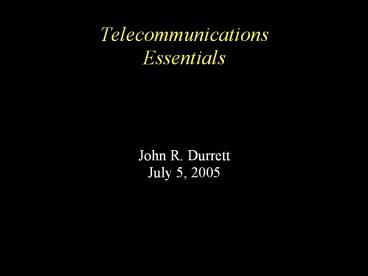Telecommunications Essentials - PowerPoint PPT Presentation
Title:
Telecommunications Essentials
Description:
Telecommunications. Essentials. John R. Durrett. July 5, 2005. CISSP CIA Triad. Confidentiality ... Protocol a standard set of rules for computer to computer ... – PowerPoint PPT presentation
Number of Views:127
Avg rating:3.0/5.0
Title: Telecommunications Essentials
1
TelecommunicationsEssentials
- John R. Durrett
- July 5, 2005
2
CISSP CIA Triad
- Confidentiality
- Integrity
- Availability
3
Basic Definitions
- Protocol a standard set of rules for computer
to computer communications - Describes format of messages
- Describes way messages are transmitted
- Enables different computers to communicate
- Allows extensions of existing standards
- Typically uses a layered model
4
Layered Architectures
- Utilizes logical groups called layers
- Helps clarify communications process
- Breaks down complexity
- Enables interoperability
- Allows changing of individual layers without
changing others - Makes for easier troubleshooting
5
(No Transcript)
6
(No Transcript)
7
TCP/IP
Application
Transport Layer
Transport Layer
Network Layer
Network Layer
Network Layer
Network Layer
Alice
Router
Bob
8
(No Transcript)
9
(No Transcript)
10
Transmission Control Protocol
- Full duplex
- Connection Oriented, packets are sequenced
- Costly in terms of network overhead
- Slower than UDP
- Syn, Ack-Syn, Ack
11
TCP Fields
Source port Destination port Sequence
number Acknowledgment number Data offset
Reserved Window Checksum Urgent
pointer Options Padding data
U R P
A C K
P S H
R S T
S Y N
F I N
12
User Datagram Protocol
- Best effort delivery only
- Connectionless
- No sequence, no error correction
- unreliable protocol
13
UDP Fields
14
Ports
Ports are used in the TCP RFC793 to name the
ends of logical connections which carry long term
conversations. For the purpose of providing
services to unknown callers, a service contact
port is defined. This list specifies the port
used by the server process as its contact port.
The contact port is sometimes called the
"well-known port".
PORT USE
17 Quote of the Day
20 File Transfer Data
21 File Transfer Control
22 SSH
23 Telnet
25 SMTP
53 DNS
gt 1024
- Source port
- Destination port
- Logical connection
- Privileged unprivileged ports
- Netstat na
15
Internet Protocol
- Network Layer Protocol
- Logical ID called an IP address
- IP sender IP recipient
- Routing decisions based on destination IP address
16
IP Address (IPv4)
- uniquely identifies a computer on a network
- 32 bits, 4 bytes of 8 bits each
- xxxxxxxx.xxxxxxxx.xxxxxxxx.xxxxxxxx
- dotted quad notation system
- Example 198.113.201.23
- There are five classes of addresses A - E.
17
Identifying a Class
Address Identifier
Network Address
Host Address
16,277,214 hosts per network ID
Class A
0-126
7 bits of network address
24 bits of host address
0
Last three bytes
First byte
65,354 hosts
Class B
128-191
14 bits of network address
10
16 bits of host address
First two bytes
Last two bytes
254 hosts
Class C
192-223
8 bits of host address
21 bits of network address
110
First three bytes
Last byte
224-239
Class D
1110
Multicast address in the range of 224.0.0.0 -
239.255.255.255
Class E
240-255
11110
Class E - Reserved for future use
18
Subnetting
Customer Site
130.1.1.0 130.1.2.0 130.1.3.0 . . . . . .
. 130.1.255.0
130.1.0.0
Internet
- Each address consists of two componentsNetwork
address and Host address - Determined by Netmask
- 10.21.41.3 00001010 00010101 00101001 00000011
- 255.255.0.0 11111111 11111111 00000000 00000000
- Network address is IP XORed with netmask































